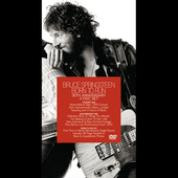|
You are reading the older HTML site
Positive Feedback
ISSUE
24
Bruce Springsteen, Born to Run - Re-mastered
and revisited
Want to break an audiophile's heart? Cue up side one of Bruce Springsteen's Born to Run. It doesn't matter whether it's the original LP, the horrid CD, or the CBS Mastersound half-speed LP. All of them sound awful, yet for the first minute of "Thunder Road," there's hope. Springsteen's voice is muffled, and the piano sounds muddy, but the music is captivating. Then the buildup begins: "Hey what else can we do now/Except roll down the window…" and you're on the edge of your seat, but just as the song crescendos, it collapses into a muddy heap of aural sludge. The music is so dynamically compressed that you might as well be listening on a clock radio, but you keep on listening because it's one of the greatest rock records of all time. You also keep buying reissue after reissue, hoping that one of them will reveal a glimmer of what it was like to be there during the sessions. Finally, thirty years after its release, Columbia has digitally remastered the CD as part of a deluxe CD/DVD package, and it sounds... a little better. At the same time, Classic Records has again reissued the LP, now on 200-gram Quiex vinyl instead of the standard 180-gram. This is the version to own. Don't expect miracles, as Classic Records was obliged to use the same source that Columbia used, but the music occupies actual, physical space for the first time. It may only be because of its exceptionally quiet background, but the new Classic LP reveals a tiny bit more detail than the others. The noise and hiss that gunked up previous issues is pretty much gone, so the notes emerge from a blacker, more neutral background instead of being mixed into the sonic filth. On "Thunder Road," the glockenspiel even sparkles a bit! Because Classic's 200-gram reissue is analog, you can make the most of it if you have the right front end. My turntable and arm sound like they were designed to enhance this LP. The Rega P3 with Linn LVV arm has a knack for propelling the music forward—compensating, in part, for the lack of dynamics—while my Denon DL-110 cartridge's cavernous soundstage opened things up just a little more. The Denon can sound unnaturally large on some recordings, but on this one, it sounds heavenly. On my system, the piano on the Classic LP doesn't have the hardness it does on the Mastersound LP, let alone the original CD. Every track sounds fuller, cleaner, more natural, and more lifelike. By necessity, I'm speaking in relative terms, but I can't imagine a better LP issue than this one unless someone finds a way to use digital correction that doesn't rob the music of its magic. I'm open to anything. Like every Classic LP, this one is correct down to the label. The gatefold jacket is sturdy, the printing is crisp and beautiful, and the pressing quality is among the best. My copy of the LP is perfectly flat, and I have played it many times without hearing a single pop or tick. I didn't even spot any mold release residue when I held it at an angle to the light. Quality control at Classic has gotten very impressive compared to the days when I would receive a warped record or find a noisy little chunk of something imbedded in the vinyl. Poor source material can't rob Born to Run of its timeless power. This stirring, cinematic, and utterly captivating piece of rock music deserves the full-tilt vinyl reissue that Classic now offers. Grab the Thirtieth Anniversary CD for the DVD bonus material, but the new Classic LP is the version to own for listening.
|

